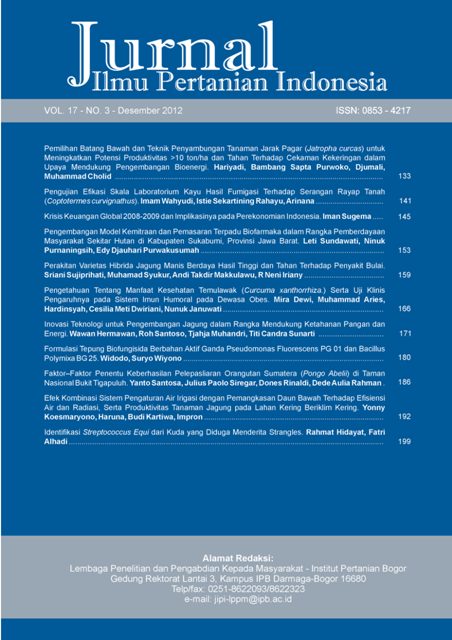Inovasi Teknologi untuk Pengembangan Jagung dalam Rangka Mendukung Ketahanan Pangan dan Energi
Abstract
Recent researches resulted several innovations such as an integrated machine for planting and fertilizer application for corn cultivation, corn noodle production, and delignification process of corn stover. The objectives of this research were (1) to improve working performances of the first prototype of integrated machine for tillage, planting, and fertilizer application for corn cultivation, (2) to develop an automatic irrigation system using solar energy, (3) to optimize processing variables on corn noodle production, and (4) to explore the delignification process of corn stover to improve the enzymes susceptibility in saccharification process. The planting and fertilizer application machine for corn cultivation has been successfully modified and showed better working performance. An automatic irrigation system using solar energy for corn cultivation has been arranged using a solar panel, a water pump, a battery, and a controlling system. The pumping discharge from a 10 m depth of well was 0.1 l/s. The optimum processing condition was resulted from the combination of 80% dough’s moisture content, at 90 °C extruder temperature and 75 rpm screw speed. The microwave heating treatment could destruct and solubilize the lignin, as compared to chemical and hydrothermal processes, and reduced the fiber crystallinity.
Downloads
References
Agbogbo FK, Coward-Kelly G. 2008. Cellulosic ethanol production using naturally occurring xylose-fermenting yeast, Pichia stipitis. Biotechnol Lett. 30: 1515-1524.
Charutigon C, Jintana J, Pimjai N, Vilai R. 2007. Effects of Processing Conditions and the Use of Modified Starch and Monoglyseride on Some Properties of Extruded Rice Vermicelli. Berlin (DE): Elsevier.
Hermawan W, Mandang T, Radite PAS. 2009. Aplikasi Mesin Pengolah Tanah, Penanam dan Pemupuk Terintegrasi untuk Peningkatan Efisiensi dan Produktivitas Jagung. Laporan Akhir Penelitian Strategis Aplikatif. Bogor (ID): Institut Pertanian Bogor.
Hill J, Nelson E, Tlman D, Polasky S, Tiffany D. 2006. Environmental, economic, and energetic costs and benefits of biodiesel and ethanol biofuels. Tersedia pada: www.pnas.org./cgi/doi/10. 1073/pnas. 0604600103, pp. 11206-11210.
Lynd LR, Weimer PJ, van Zyl WH, Pretorius IS. 2002. Microbial Cellulase Utilization: Fundamentals dan Biotechnology. Microbiol Molec Biol Rev. 66(3): 506-577.
Miller GL. 1959. Use of Dinitrosalicyclic Acid Reagent for Determination of Reducing Sugar. Anal. Chem. 31: 426-428.
Muhandri T, Subarna, Nurtama B. 2008. Karakterisasi Tepung Berbagai Varietas Jagung Kuning Dan Potensinya Untuk Dibuat Mi Jagung. Laporan Hibah Bersaing. Bogor (ID): Institut Pertanian Bogor.
Nularif PS. 2010. Karakteristik sifat amilografi tepung jagung termodifikasi [skripsi]. Bogor (ID): Institut Pertanian Bogor.
Sunarti TC, Richana N. 2008. Produksi selulase Trichoderma viride dari tongkol jagung dan fraksi selulosanya. J Penel Pascapanen Pert. 4(2): 57-64.
Sunarti TC, Meryandini A, Sofiyanto ME, Richana N. 2010. Saccharification of corncob using cellulolytic bacteria for bioethanol production. Biotropia. 17(4): 105-115.
Van Soest PJ. 1963. Use of Detergent in Analysis of Fibrous Feeds III. In: M.L. Dreher (ed.). The Handbook of Dietary Fiber. New York (US): Marcel Dekker.
Wagiman, Fauzi AM, Mangunwidjaja D, Sukardi. 2011. Efek perlakuan kimiawi dan hidrotermolisis pada biomassa tanaman jagung (Zea mays L.) sebagai substrat produksi bioetanol. Agritech 31(2): 89-98.
This journal is published under the terms of the Creative Commons Attribution-NonCommercial 4.0 International License. Authors who publish with this journal agree to the following terms: Authors retain copyright and grant the journal right of first publication with the work simultaneously licensed under a Creative Commons Attribution-NonCommercial 4.0 International License. Attribution — You must give appropriate credit, provide a link to the license, and indicate if changes were made. You may do so in any reasonable manner, but not in any way that suggests the licensor endorses you or your use. NonCommercial — You may not use the material for commercial purposes.



















